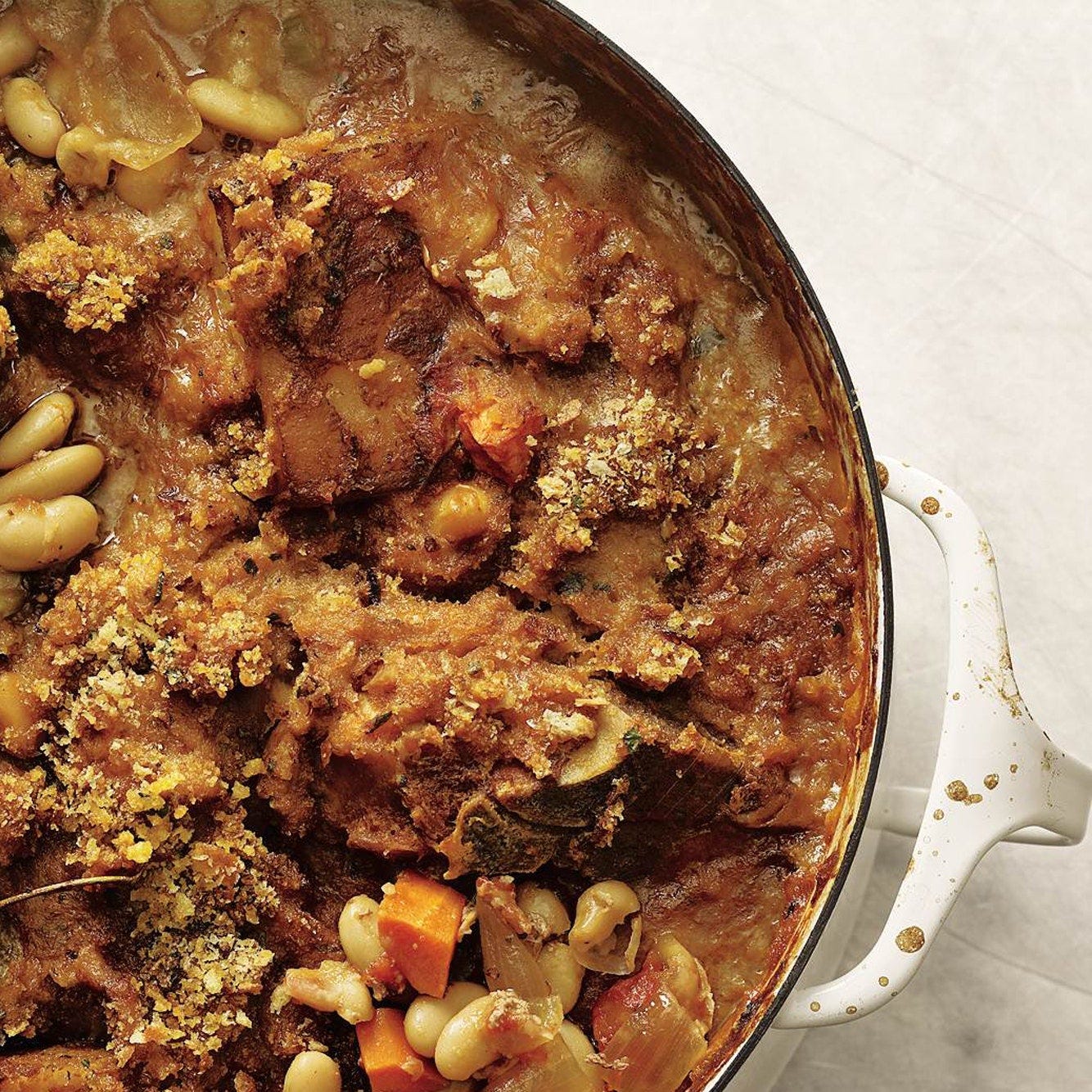My mother was an exceptionally creative self-taught cook. But she saved one of her best meals for whenever my father’s work took him away from home. She’d drag the TV into their bedroom. My sister and I would snuggle under the bedcovers and wait for her to slide in beside us with a tray heavy with a scalding terracotta dish of Heinz Baked Beans bubbling under a thick melting coat of grilled Cheddar cheese. We’d tuck in, scalding our tongues, eyes glued to the telly, teeth glued to the gloopy, rib-sticking beans.
Brits love baked beans so much that until last year we even had a private museum dedicated to them, The Baked Bean Museum of Excellence. Opened in 2009 by Barry Kirk who formally changed his name to Captain Beany, it was located in Wales, in the sitting room, kitchen, and even the bathroom of his Port Talbot council flat.
Baked beans were introduced to the British by the Great Bean Behemoth himself. Henry J Heinz showed up in 1886 with 5 cases of canned baked beans to pitch Fortnum & Mason, the London luxury department store on Piccadilly. The buyer was captivated - as quickly after was the entire nation, to the point that Brits now eat more Heinz Baked Beans than the entire rest of the world put together, over 2 million cans each day. (And there are a mere 68 million of us of which countless numbers are excluded from the pleasure of the baked beans experience by dint of being at the gurgling stage of life.)
Although the Heinz Baked Beans originally sold in the UK were made to the traditional US recipe, Heinz was quickly forced to tweak it, removing the pork fat. More significantly, to meet British and Irish tastes they are far less sweet, the traditional maple syrup, molasses or brown sugar of the American version dramatically reduced.
The extent of the American sweet tooth is startling. Scientists may assert sugar isn't an addictive compound but consumption figures don't appear to agree. Nor, it seems, do advertisers. There's 2015’s ‘Brady Bunch’ ad promoting the corrective effect of Snickers when sugar has been withdrawn.
It led to their later campaigns’ novel concept of being ‘hangry’, an anger resulting from being hungry, reversed only by the speedy intake of sugar in the form of a Snickers bar.
Meanwhile, the WHO (World Health Organization) recommends 25 grams or 5¾ teaspoons of sugar per person per day at the very most. USA per capita sugar consumption is five times that - 126.4 grams or just under 30 teaspoons. Daily. This translates to more than ten times the American Heart Association’s recommended intake of 11 grams per day, and makes the United States the biggest consumer of sugar on the globe. Figures from the research agency of the USDA (United States Department of Agriculture) are even more alarming: 34 teaspoons of a sugar a day, equal to more than 500 calories. Over a year, it averages out at over 45kg/100 pounds of sugar per person.

A significant percentage of that is invisible, contained in American foods and drinks in a variety of forms. The sweetness level in processed American bread is just one of the culinary surprises awaiting visitors from other countries tucking into their first morning’s toast. While sugar is the most familiar sweetener, the list includes sucrose (a type of sugar), honey, maltose, dextrose, molasses, and my big bug bear, High Fructose Corn Syrup. HFCS is ubiquitous because it's so much cheaper than sugar.
US governments propose reduction or removal of corn subsidies at their peril: the Corn Belt has very little coal or heavy industry, most of its counties driven primarily by corn farming and ethanol production. Since 1983, the US sugar industry has been protected by the imposition of trade tariffs on foreign-produced sugar. In the 1970s, corn growers from the Great Plains through to Ohio, most of whom farm on an industrial scale, were encouraged by massive government subsidies to produce corn as a cheaper replacement for sugar. Those subsidies, 79 percent of them going to the largest 10 percent of producers, have incentivised them to produce as much as they can, making corn the top American crop, worth nearly $90 billion, and the USA the largest producer in the world. 96,000,000 acres of land - 5 percent of the US landmass - is reserved for planting corn. The crop accounts for 55 percent of global consumption of High Fructose Corn Syrup. (Of those 96,000,000 acres, 90 percent gets planted with biotech seeds should Genetic Modification, restricted and regulated in Europe and the UK, be a concern of yours. Though not actively banned in Europe and the UK, there's little reason to use HFCS as it isn't subsidised as it is so very generously in the US.)
Present in pretty much every processed food from baked goods, canned and packaged foods, condiments, jams, yogurts to fast-foods, candies and soft drinks, there was a time during the 2000s when HFCS came under fire for health reasons, associated widely with an increase in obesity, liver fat and Type 2 diabetes. Studies, mainly American, have concluded since that there is no evidence of a direct health risk. But as with an over-consumption of sugar, too much HFCS increases the body’s fat production and affects insulin sensitivity. In the USA, HFCS makes up 40 percent of the sweeteners in processed foods, drinks, cereals and baked goods. So it would surely be hard to deny there is a link between HFCS and obesity and its attendant problems among those forced to depend upon more affordable processed foods.
Clearly, it is healthier to reduce the consumption of sweeteners of every kind. Perhaps US manufacturers might start by emulating Heinz’ action for the British market and reduce the sweetness of their canned goods, ketchups, processed foods and more for American diners.
Beans, along with all other legumes, are cheap, filling and nutritious. The French, not the Americans nor the British, have taken the humble baked bean and run with it. Cassoulet is a great rib-sticking winter warmer, all the better for being made one or two days ahead for its flavours to mellow, then reheated.
Castelnaudary, in the Occitane region of southwest France, claims to have originated the first cassoulet, long before America was a twinkle in colonialist eyes. But Carcassonne and Toulouse, also in the southwest, have equal claim to its invention with their own thoroughly different recipes. There are probably as many of recipes as there are of cooks adding personal variations to a slow-cooked gratin of beans. One story relating to its invention sets it during the Hundred Years’ War waged between 1337 and 1453 by England and France over territorial rights after Edward III invaded Flanders to assert his claim to the French crown. Beleaguered citizens rounded up all the ingredients they could find and cooked up a stew to keep their defenders going. It’s a picturesque tale but a little hard to swallow as beans were brought to Europe from the Americas by Columbus, sometime around 1493.
Traditionally, cassoulets were cooked in the hearth or the baker’s oven, their residual heat slowly allowing the beans to break down and the flavour and fat of the meat to melt into them. "Cassoulet, that best of bean feasts,” said Julia Child, “is everyday fare for a peasant but ambrosia for a gastronome.”
This feeds 12, or a few of you often. Don’t be daunted by the length of the recipe. Turn on the radio, pour yourself a glass of wine and get stuck in. You can even do it in stages over the course of 2-3 days. Your nearest and dearest will be grateful, and you are likely to be really quite pleased with yourself.
1.5kg/3 lb white haricot beans (Tarbais are best but Great Northern absolutely fine)
water
12 ounces pancetta, in one piece
10 cloves garlic, peeled
2 medium onions, skinned and studded with 5 cloves
1 carrot, peeled
1 bouquet garni (5 parsley sprigs, 3 celery leaves, 1 thyme sprig, 1 bay leaf and 10 peppercorns, wrapped in cheesecloth and tied)
6 confit duck legs (available on internet if not at your butcher), cut in half at the joint
500g/1lb shoulder or breast of lamb, cut into 2.5cm/1in pieces
500g/1lb boneless pork loin or shoulder, cut into 2.5cm/1in cubes
500g/1lb Toulouse (garlic) sausages
3 tablespoons tomato paste
Salt and pepper to taste
100g/3½ oz breadcrumbs
4 tablespoons duck fat, room temperature soft
Soak the beans in plenty of water overnight, drain them then add to a large, lidded casserole, along with the pancetta, garlic, onions, carrot and bouquet garni. Cover by at least 7½cms/3 ins water. Bring to a boil over medium-high heat, skim off any foam, then reduce heat to low and simmer, uncovered, until the beans are barely tender, about 1 hour.
Drain everything through a colander, reserving the liquid. Discard the carrot, onion and bouquet garni, and dump beans into a large mixing bowl. Remove pancetta and set aside. Season beans with 1 teaspoon of salt and freshly ground black pepper.
Preheat oven to 150C/300F.
In a large frying pan, in separate batches, sear the duck, meats and sausages over medium-high heat until just browned, removing each element to a separate platter while finishing each meat.
Lightly grease a large non-reactive casserole with duck fat on the bottom and sides. Spread half the bean mixture into it. Add the duck legs and meats, holding back the sausages and pancetta. Cover with the remaining beans.
Stir the tomato paste into a cup of the beans water, mix well until dissolved. Pour evenly over the beans then pour in enough of the bean water to cover the beans by 2.5cm/1in. Don’t pour away any remaining water.
Bake until hot and bubbling, about 2½-3 hours, checking occasionally to make sure the beans are not drying out. If they are, pour over a ladle of bean water. You want the gloopy consistency of a can of Baked Beans.
An hour before the end, slice the sausages into thick slices on the diagonal and the pancetta into 1¼cm/ ½in cubes and stir into the casserole, adding another ladle of water if necessary. Sprinkle over the breadcrumbs and dot with the duck fat and continue to bake.
You can make the cassoulet up to this point 3 days ahead but don’t sprinkle over the breadcrumbs.
To finish, heat in a 190C/375F oven for 1-1½ hours till bubbling. Serve with a butter lettuce salad coated in a mustardy vinaigrette.





Full of informative interest as usual, Julia! I occasionally watch clips from an American influencer, who does comparisons between British and American food - he seems to prefer the less-sweet British version of just about everything, includig baked beans. And there I was, thinking Castelnaudary was famous for the Foreign Legion ... good to know it has connections with one of my favourite dishes, as well! I shall be making that cassoulet and taking it to my Regimental Association's annual camp next year. Of course, I shall have to have a trial run or two at home before then ...
I’m always in awe of how you weave together so many threads — and still manage to rail on Big Food! Now that the weathers getting colder, this may be the year I finally attempt a cassoulet.